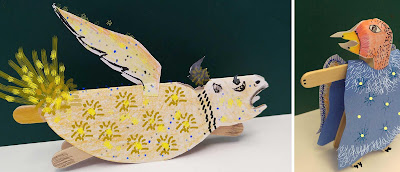Workshop 3
The Wonders of Creation manuscript, 16th c. edition was written by Murshid al-kātib al-Shīrāzī is housed at the Chester Beatty
Description of the manuscript: The Wonders of Creation originally was written by Qazvini, a 13th C. Persian physician, astronomer, geographer and proto-science fiction writer. Qazvini was born in Qazvin, a city in Iran, located in 150 km (93 mi) Northwest of Tehran (the capital of Iran).
The Wonders of Creation is an important work of cosmography. The manuscript includes the science that maps the general features of the universe, describing both the Heaven (Sky) and the Earth.
Qazvini's cosmography consists of two parts:
1. The first part is celestial, dealing with the spheres of heaven with its inhabitants (the angels) that has 7 levels.
2. The second part discusses the terrestrial (the Earth): the four elements (wind, fire, air, wood/earth), the (Ptolemy’s) seven climes, seas and rivers, the living creatures, the plants, and the minerals.
In Qazvini's classification, there are seven types of living creatures: man, jinn, animals used for riding, animals that graze, beasts, birds and insects, and creatures that look strange or are hybrids.
Curriculum:
Workshop Title:
The Vivid ForesightImaginary Scientific Characters, (Part II: Sculptures)
Lesson Overview: Students explore three topics (Angels, Monsters, and Hybrid Animals) from medieval time in Iran through pages of The Wonders of Creation. Students learn how to draw their selected characters on paper first, and then how to create 3-D models, using clay.
Author: Pantea Karimi
Author: Pantea Karimi
Subjects: Visual Arts, Science Fiction
Main Resource: Chester Beatty Library Archives
Workshop Time: Morning: 10:30 to 1:00 Afternoon: 1:45 to 4:15
Age Groups: Morning, 12-14 Afternoon: 15-17
Use of technology in the classroom: Students are given the opportunity to explore science fiction characters, or other relevant topics on the internet using provided tablets.
Vocabulary:
Science fiction (often abbreviated Sci-Fi) is a genre of fiction. It typically deals with imaginative and futuristic concepts such as advanced science and technology, time travel, parallel universes, fictional worlds, or space exploration.
Proto-Science Fiction referred to as the 'really old stuff before science fiction was even a genre.
Jinn: an intelligent spirit of lower rank than the angels, able to appear in both human and animal forms
Cosmography: the science that deals with the general features of the universe, including the earth. The branches of cosmography include astronomy, geography, and geology.
Jinn: an intelligent spirit of lower rank than the angels, able to appear in both human and animal forms
Cosmography: the science that deals with the general features of the universe, including the earth. The branches of cosmography include astronomy, geography, and geology.
Goals:
· Develop Visual Literacy and explore historical archives
· Develop a practicum based on the history of science through scientific manuscripts and
· Explore the intersection of art and science
· Use art as a tool to explore scientific content
· Effectively use the art and science resources offered by the Chester Beatty Library
Learning Objectives:
· Exercise and demonstrate the use of the elements of design
· Use materials, tools and processes from a variety of media (drawing, sculpting, and craft)
· Handle materials effectively
· Create original works of art in a specific medium using specific content
· Produce creative works that demonstrate innovation in concepts, formal language and/or materials
· Describe, analyze and interpret created artwork
· Demonstrate problem-solving skills by providing a step-by-step approach to specific issues in workshop projects
· Learn and explore science through the lens of art
Materials: Drawing papers, pencil, eraser, scissors, ruler
Copies of images for inspiration (refer to the end of this document)Self-hardening Clay
Required time: 20 minutes: introduction- presentation by the teacher
10 minutes sketching and pondering ideas
2 hours of lab time (students develop their own works)
Project Steps:
Project Steps:
step 1. Students use 1 drawing paper to draw their characters or hybrid animals based on the select manuscript images. See below, images 1-5 for select manuscript images
step 2. Students use one or two of their drawn characters and create them in 3-D, using clay. See below, images 6-11
step 3. Students add details to their characters using clay
Assessment:
Students will be assessed on:
· Use of creative ideas to design science characters
· Good building skills to create a 3-D model
· Ability to envision the final characters and adding details accordingly
Images from The Wonders of Creation:
For the purpose of this workshop, images are selected from three categories in the manuscript:
Category 1: Angels (Feresh-teh in Persian or
Malaa-ek in Arabic)
Category 2: Monsters (Deev in Persian or Shaytaan in Arabic)
Category 3: Hybrid Animals (Imaginary animal-characters)
Category 2: Monsters (Deev in Persian or Shaytaan in Arabic)
Category 3: Hybrid Animals (Imaginary animal-characters)
image 1 (angels)
image 2 (hybrid animal)
image 3 (hybrid animal)
image 4 (monsters)
image 5 (monster)
samples made using clay for students to see examples of what can be made
Students' Works, Dublin, Ireland:
image 6
image 7
image 8
image 9
image 10
image 11
photo by Chester Beatty, students at the sculpting workshop















